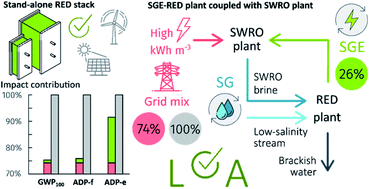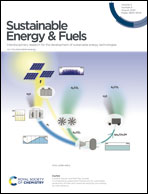Life cycle assessment of salinity gradient energy recovery by reverse electrodialysis in a seawater reverse osmosis desalination plant†
Abstract
Salinity gradient energy capture by reverse electrodialysis (SGE-RED) can play a part in the shift away from fossil fuels towards a carbon-neutral renewable energy supply; however, like other renewable power technologies, SGE-RED environmental soundness hinges on its whole life-cycle environmental loads. This study surveys the Life Cycle Assessment of SGE-RED technology. We quantified (i) the environmental loads per 1.0 kW h generated by a stand-alone RED unit and then, (ii) the environmental burdens related to the energy provision from an up-scaled RED system to a seawater reverse osmosis (SWRO) desalination plant per 1.0 m3 of desalted water. The RED unit's assessment results show that SGE-RED is environmentally competitive with other renewable sources such as photovoltaics or wind. Regarding the component's contribution analysis, the spacer's fabric material drives the RED environmental burden as the number of cell pairs is increased. The scaling-up of the RED unit, however, improves its full environmental profile. Preliminary results of SGE-RED combination with a SWRO plant suggest that the energy harnessed from SWRO's concentrate streams by RED could enhance the environmental performance of the desalination industry. Further research is required to identify SWRO-RED design alternatives that minimize the life cycle burden while still yielding good technical and economic performance.



 Please wait while we load your content...
Please wait while we load your content...